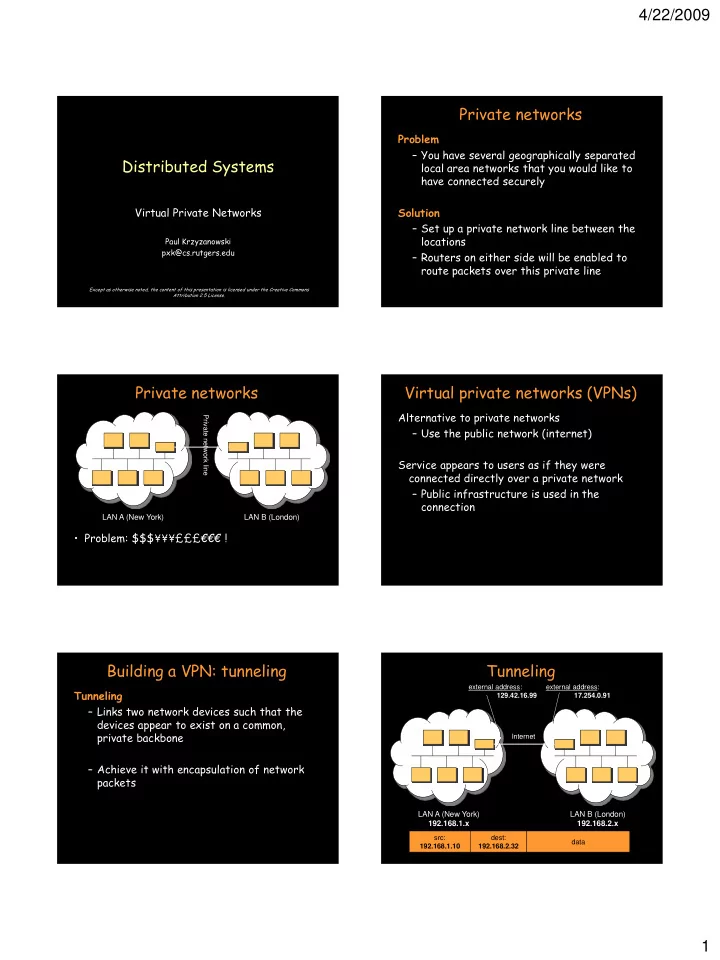

4/22/2009 Private networks Problem – You have several geographically separated Distributed Systems local area networks that you would like to have connected securely Virtual Private Networks Solution – Set up a private network line between the locations Paul Krzyzanowski pxk@cs.rutgers.edu – Routers on either side will be enabled to route packets over this private line Except as otherwise noted, the content of this presentation is licensed under the Creative Commons Attribution 2.5 License. Private networks Virtual private networks (VPNs) Alternative to private networks Private network line – Use the public network (internet) Service appears to users as if they were connected directly over a private network – Public infrastructure is used in the connection LAN A (New York) LAN B (London) • Problem: $$$¥¥¥£££ €€€ ! Building a VPN: tunneling Tunneling external address: external address: Tunneling 129.42.16.99 17.254.0.91 – Links two network devices such that the devices appear to exist on a common, private backbone Internet – Achieve it with encapsulation of network packets LAN A (New York) LAN B (London) 192.168.1.x 192.168.2.x src: dest: data 192.168.1.10 192.168.2.32 1
4/22/2009 Tunneling Tunneling LAN A (New York) LAN B (London) LAN A (New York) LAN B (London) 192.168.1.x 192.168.2.x 192.168.1.x 192.168.2.x Internet Internet external address: external address: external address: external address: 129.42.16.99 17.254.0.91 129.42.16.99 17.254.0.91 - route packets for 192.168.2.x to VPN router -accept packets from 129.42.16.99 - envelope packet -extract data (original IP packet) - send it to remote router -send on local network src: dest: src: dest: src: dest: src: dest: data data 129.42.16.99 17.254.0.91 192.168.1.10 192.168.2.32 129.42.16.99 17.254.0.91 192.168.1.10 192.168.2.32 Building a VPN: tunneling Building a VPN: security Operation No need to make all machines in the local area networks accessible to the public network … just the router – LAN-1 and LAN-2 each expose a single outside address and port. – A machine in the DMZ (typically running firewall software) BUT … an intruder can: listens on this address and port – On LAN-1, any packets addressed to LAN-2 are routed to – examine the encapsulated packets this system. – forge new encapsulated packet • VPN software takes the entire packet that is destined for LAN-2 and, treating it as data, sends it over an established TCP/IP connection Solution: to the listener on LAN-2 – encrypt the encapsulated packets – On LAN-2, the software extracts the data (the entire packet) and sends it out on its local area network • Symmetric algorithm for encryption using session key – need mechanism for key exchange IPSEC: RFC 1825, 1827 IPSEC • IP-layer security mechanism simple tunnel • Covers authentication and encryption • Application gets benefits of network encryption without src: dest: src: dest: data modification 129.42.16.99 17.254.0.91 192.168.1.10 192.168.2.32 • Additional header added to packet: with AH signature – IP Authentication header • Identifies proper source and destination – basis of point-to- src: dest: src: dest: point authentication data 129.42.16.99 17.254.0.91 192.168.1.10 192.168.2.32 • Signature for IP header • Encapsulating Security Protocol ( ESP ) • Tunnel mode: encrypt entire IP packet (data and IP/TCP/UDP Authentication header. Validate: headers) -Packet not modified -Packet originated from peer • or Transport mode: encrypt only IP/TCP/UDP headers (faster) with AH+ESP • Encryption via RC4. DES. DES3, or IDEA • Key management: manual, Diffie-Hellman, or RSA src: dest: src: dest: data 129.42.16.99 17.254.0.91 192.168.1.10 192.168.2.32 signature 2
4/22/2009 PPTP • PPTP: point-to-point tunneling protocol • Extension to PPP developed by Microsoft • Encapsulates IP, IPX, NetBEUI The end • Conceptually similar to IPSEC – Flawed security 3
Recommend
More recommend